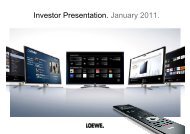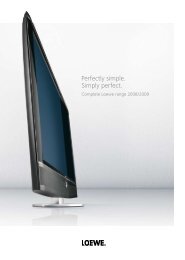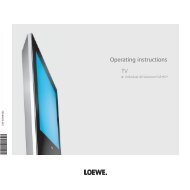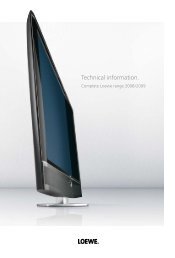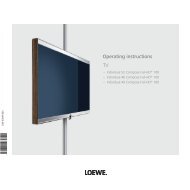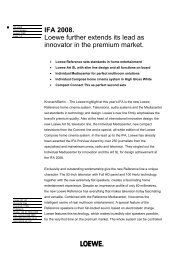Perfection in Home Entertainment. - Loewe
Perfection in Home Entertainment. - Loewe
Perfection in Home Entertainment. - Loewe
You also want an ePaper? Increase the reach of your titles
YUMPU automatically turns print PDFs into web optimized ePapers that Google loves.
Dolby Digital<br />
The digital standard for high-quality<br />
home c<strong>in</strong>ema systems. With this standard<br />
<strong>in</strong>dividual channels are transmitted<br />
separately. The three front channels<br />
on the right, left and centre, the two<br />
surround channels on the right and left<br />
and the external subwoofer channel are<br />
also termed as a 5.1 signal.<br />
Dolby Digital Plus<br />
Dolby Digital Plus is a new, improved<br />
process for encrypt<strong>in</strong>g audio signals. It is<br />
compatible with modern home c<strong>in</strong>ema<br />
systems and is supported by <strong>Loewe</strong> Bluray<br />
players, for example.<br />
Dolby ProLogic<br />
Converts Dolby coded stereo signals <strong>in</strong>to<br />
surround sound. It usually features four<br />
channels (left, centre, right, surround).<br />
No special subwoofer channel is created.<br />
Dolby ProLogic II<br />
A newer version of Dolby Pro Logic.<br />
Us<strong>in</strong>g highly advanced mathematical<br />
models this process generates six-channel<br />
surround sound (left, centre, right,<br />
surround right, surround left, subwoofer)<br />
from a stereo or Pro Logic signal.<br />
Dolby TrueHD<br />
Is a surround sound format with no<br />
loss of quality for up to 7.1 channels<br />
developed for high-def<strong>in</strong>ition media<br />
such as Blu-ray. The audio data is<br />
uncompromised and therefore identical<br />
to the orig<strong>in</strong>al record<strong>in</strong>g <strong>in</strong> the studio.<br />
A separate decoder is required for<br />
playback. Dolby TrueHD is read by the<br />
<strong>Loewe</strong> Blu-ray player, for example, and<br />
then released to the digital output.<br />
Dolby Virtual Speaker technology<br />
Dolby Virtual Speaker technology simulates<br />
surround sound playback from a real 5.1<br />
channel speaker system with just two<br />
speakers. This uses advanced algorithms<br />
and technologies for room model<strong>in</strong>g, <strong>in</strong><br />
order to reproduce the audio spectrum<br />
and dynamics of real 5.1 channel speakers.<br />
Dolby Virtual Speaker complements<br />
modern flat-screens and is ideal for rooms<br />
<strong>in</strong> which a 5.1 speaker system cannot be<br />
used due to cost or <strong>in</strong>stallation effort.<br />
Downscal<strong>in</strong>g/upscal<strong>in</strong>g<br />
By connect<strong>in</strong>g various equipment<br />
products via a digital AV <strong>in</strong>terface,<br />
the TV set receives different signals<br />
<strong>in</strong> different resolutions. The electronic<br />
system <strong>in</strong> the TV recognises this and<br />
automatically adjusts the resolution<br />
to match the display resolution. This<br />
means, for example, that when a laptop<br />
is connected, the 640 x 480 pixels<br />
resolution is automatically upgraded<br />
to the optimal display resolution of<br />
1.366 x 768 pixels.<br />
dts – Digital Theatre Sound<br />
Along with the well-known Dolby Digital<br />
5.1 format, many films are now mixed <strong>in</strong><br />
the dts Digital Surround format <strong>in</strong> order<br />
to achieve an effective 5.1 surround<br />
sound effect. <strong>Loewe</strong> DVD recorders,<br />
Blu-ray players and audio systems support<br />
dts surround sound.<br />
dts HD<br />
Is a new sound format, <strong>in</strong> which highdef<strong>in</strong>ition<br />
audio signals are encrypted<br />
with up to 7.1 channels. It is compatible<br />
with current 5.1 home c<strong>in</strong>ema systems<br />
and is supported by <strong>Loewe</strong> Blu-ray<br />
players, for example. dts HD is available<br />
<strong>in</strong> two forms: as dts HD High Resolution<br />
(HR) Audio, where data is compromised,<br />
sav<strong>in</strong>g memory, and dts HD Master<br />
Audio, which is uncompromised and<br />
therefore identical to the orig<strong>in</strong>al mix<br />
<strong>in</strong> the sound studio.<br />
DR+<br />
The <strong>in</strong>tegrated DR+ hard disk recorder is<br />
optionally available ex works for almost<br />
all <strong>Loewe</strong> TVs. This allows you to record<br />
television programmes very easily at the<br />
touch of a button, or <strong>in</strong>terrupt the current<br />
programme by press<strong>in</strong>g the pause button<br />
on your <strong>Loewe</strong> remote control, and even<br />
rew<strong>in</strong>d television with the backwards<br />
button. HDTV programmes can also be<br />
recorded this way.<br />
Dual Laser<br />
Different types of discs such as DVDs or<br />
CDs place different demands on the laser.<br />
That’s why <strong>Loewe</strong> puts two lasers <strong>in</strong> all<br />
DVD players and audio systems. One laser<br />
is designed especially to read DVDs and<br />
a second is used to read CDs (<strong>in</strong>clud<strong>in</strong>g<br />
home recorded CD-Rs or CD-RWs). As<br />
each laser is specifically designed for<br />
one task, the best audio and video<br />
performance is guaranteed.<br />
DVB<br />
DVB describes the standards currently<br />
established <strong>in</strong> Europe for broadcast<strong>in</strong>g<br />
digital content (e. g. television, radio,<br />
multi-channel sound, EPG, Teletext and<br />
other additional services). The most<br />
important standards today are DVB-T,<br />
DVB-C and DVB-S/S 2.<br />
DVB-T<br />
DVB-T describes the digital broadcast of<br />
content via the antenna (Terrestrial).<br />
DVB-C<br />
DVB-C describes the digital broadcast of<br />
content via the cable network.<br />
DVB-S bzw. DVB-S 2<br />
DVB-S describes the digital broadcast of<br />
programmes via satellite. DVB-S 2 is a<br />
further developed version of this standard<br />
and <strong>in</strong>creases the transfer rate by up<br />
to 30 % (through the use of improved<br />
codification, modulation and error<br />
correction processes). Today, the majority<br />
of HDTV content is broadcast <strong>in</strong> the<br />
DVB-S 2 standard.<br />
134 / 135



